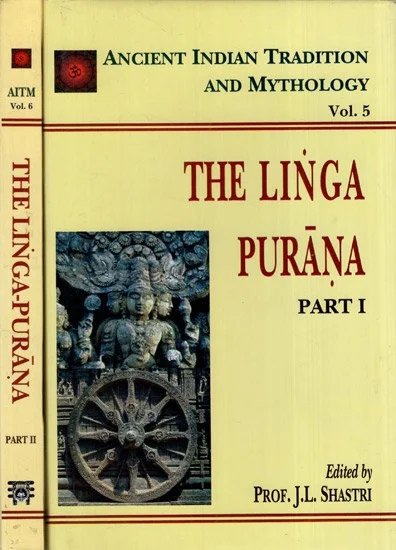The Linga Purana
by J. L. Shastri | 1951 | 265,005 words | ISBN-10: 812080340X | ISBN-13: 9788120803404
This page describes Tandava dance of Shiva which is chapter 106 of the English translation of the Linga Purana, traditionally authored by Vyasa in roughly 11,000 Sanskrit verses. It deals with Shaiva pilosophy, the Linga (symbol of Shiva), Cosmology, Yugas, Manvantaras, Creation theories, mythology, Astronomy, Yoga, Geography, Sacred pilgrimage guides (i.e., Tirthas) and Ethics. The Lingapurana is an important text in Shaivism but also contains stories on Vishnu and Brahma.
Chapter 106 - Tāṇḍava dance of Śiva
The sages said:
1. We have heard about the nativity of the elder brother of Skanda. It behoves you now to tell us precisely wherefore and how Lord Siva begins his Taṇḍava dance.
Sūta said:
2. Dāruka born in the family of Asuras attained heroism through his penance. Like the fire at the end of a yuga he killed Devas as well as brahmins.
3-7. Devas were extremely afflicted and hurt by Dāruka. They sought refuge in Brahmā, Īśāna, Kumāra, Viṣṇu, Yama and Indra. Knowing that the Asura could be killed only by a woman, he was confronted in a battle by Indra[1] and others in fine guises of women. Still they were overwhelmed by him. O brahmins, they approached Brahmā and acquainted him with everything. Accompanied by Brahmā they approached the lord of Umā. With Brahmā at the forefront, they eulogised him. Approaching the lord of Devas and bowing to him in diverse ways Brahmā said:—“O lord, the demon Dāruka is a terrible fellow. We have been defeated by him at the outset. It behoves you to protect us by killing Dāruka who is destined to be killed by a lady.
8. On hearing this submission of Brahmā the lord who destroyed the eyes of Bhaga, said laughingly to the goddess, the daughter of the mountain-lord.
9. O splendid and good-looking lady, I am now requesting you for the welfare of the worlds to slay Dāruka who is destined to be killed by a lady.
10. On hearing his words, the goddess[2] entered the body of the lord, she being desirous of taking birth from the lord of Devas.
11. She entered the lord of Devas the most excellent Deva only in part.[3] But Brahmā and Devas such as Indra and others did not know this.
12. On seeing the splendid daughter of the lord of the mountains stationed by the side of the lord as before, even the omniscient four-faced lord Brahmā was deluded by her Māyā.
13. Having entered the body of the lord of Devas, Pārvatī made her own body out of poison in the neck of the lord.
14. On coming to know of this the enemy of Kāma (i.e., Śiva) created Kali the blue-necked goddess with matted hair from his third eye.
15. When the black-necked goddess was born the glory of victory too originated. Now Bhavānī and Parameśvara were sure to inflict defeat over the demon.
16. On seeing Kālī who resembled fire and whose black neck was embellished with poison, taking her origin, Devas and Siddhas, the chief of whom were Viṣṇu, Brahmā and Indra, fled, due to fright.
17. Similarly, an eye manifested itself in the forehead, the exalted contour of the crescent moon on the head, the terrible poison in the neck, the sharp and the terrible trident in the arm and the ornaments in their respective places.
18. Along with the goddess were born the lords of Siddhas as well as Piśācas who wore divine garments and who were bedecked in ornaments.
19. At the behest of Pārvatī, the great goddess slew the demon Dāruka who used to attack and kill the chiefs among Devas.
20. O leading brahmins, by virtue of impetuosity, and the fire of anger, the entire universe became agitated.
21. Bhava assumed the form of a boy due to his power of Māyā and stationed himself in the cremation ground full of corpses and ghosts. īśvara, then cried in order to quaff the fire of her anger.
22. O brahmins, on seeing the boy, who was actually Īśāna the goddess was deluded by his Māyā. She took him, kissed him on his head and suckled him at her breasts.
23. Along with her breast-milk the boy quaffed up her warth also and he became the protector of the holy centres.
24. He assumed eight[4] physical forms for his manifestation as the intelligent protector of holy centres. Thus, her excessive anger was ceased by that boy.
25-28. In order to propitiate her, the delighted tridentbearing lord of Devas performed the tāṇḍava dance at dusk, along with the ghosts and leaders of goblins. After quaffing the nectar-like dance of Śiva upto the throat [i.e. after enjoying the dance of Śiva very much] Parameśvarī danced in the midst of ghosts, happily along with Yoginīs. Devas all round, including Brahmā, Indra and Viṣṇu, bowed to and eulogised Kālī and then prayed to the goddess Pārvatī. Thus, the Tāṇḍava of the trident-bearing lord has been briefly mentioned to you. Others[5] are of the opinion that the Tāṇḍava of the lord is due to the Bliss of yoga.
Footnotes and references:
[1]:
For brahmādyaiḥ read śakrādyaiḥ. The former reading does not suit the context.
[3]:
ekāṃśena—svakīya-ṣoḍaśa-bhāgena Śivatoṣiṇī. by her sixteenth part.
[4]:
mūrtayo'ṣṭau—Śivatoṣiṇī. adds:—[tāstu kāśyām prasiddhāḥ];—the eight forms of Bhairava are represented by their respective images in Vārāṇasī.
